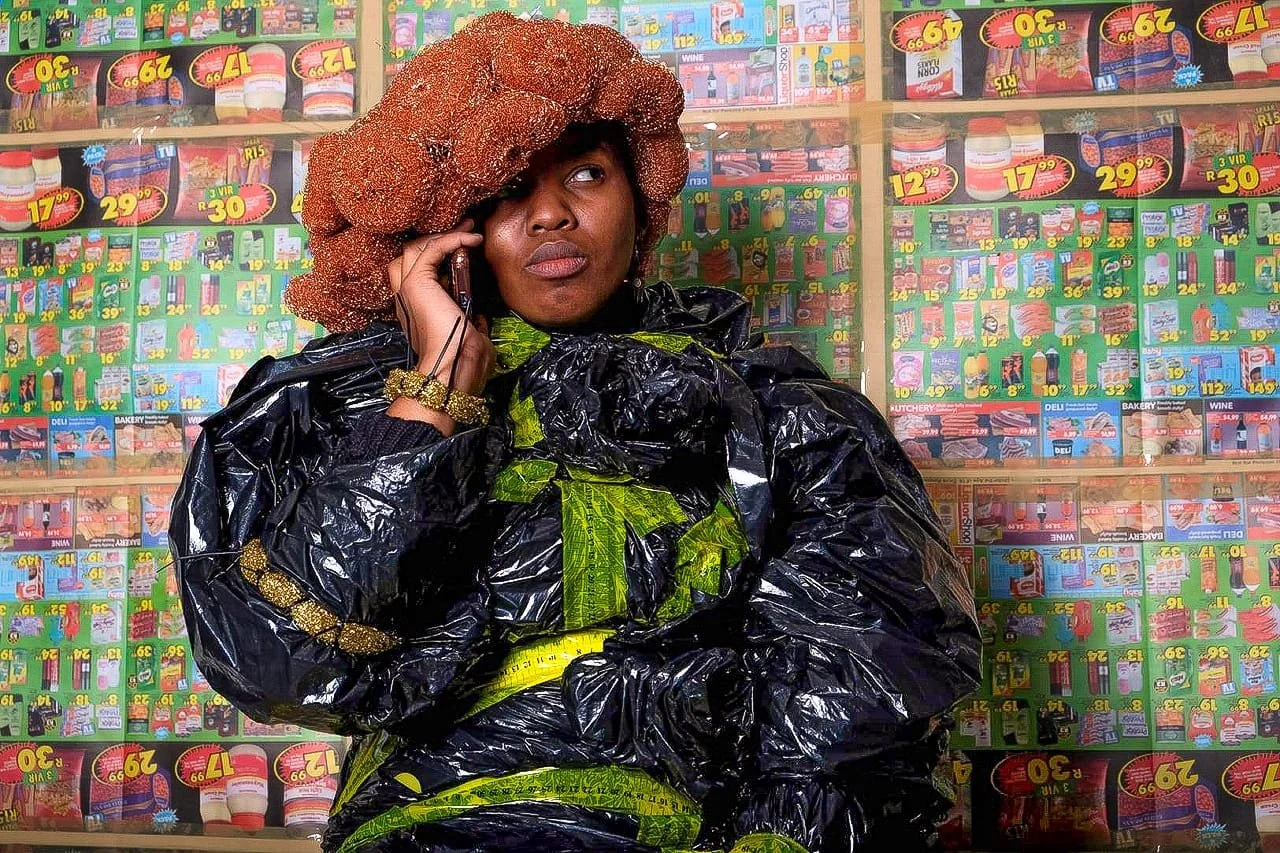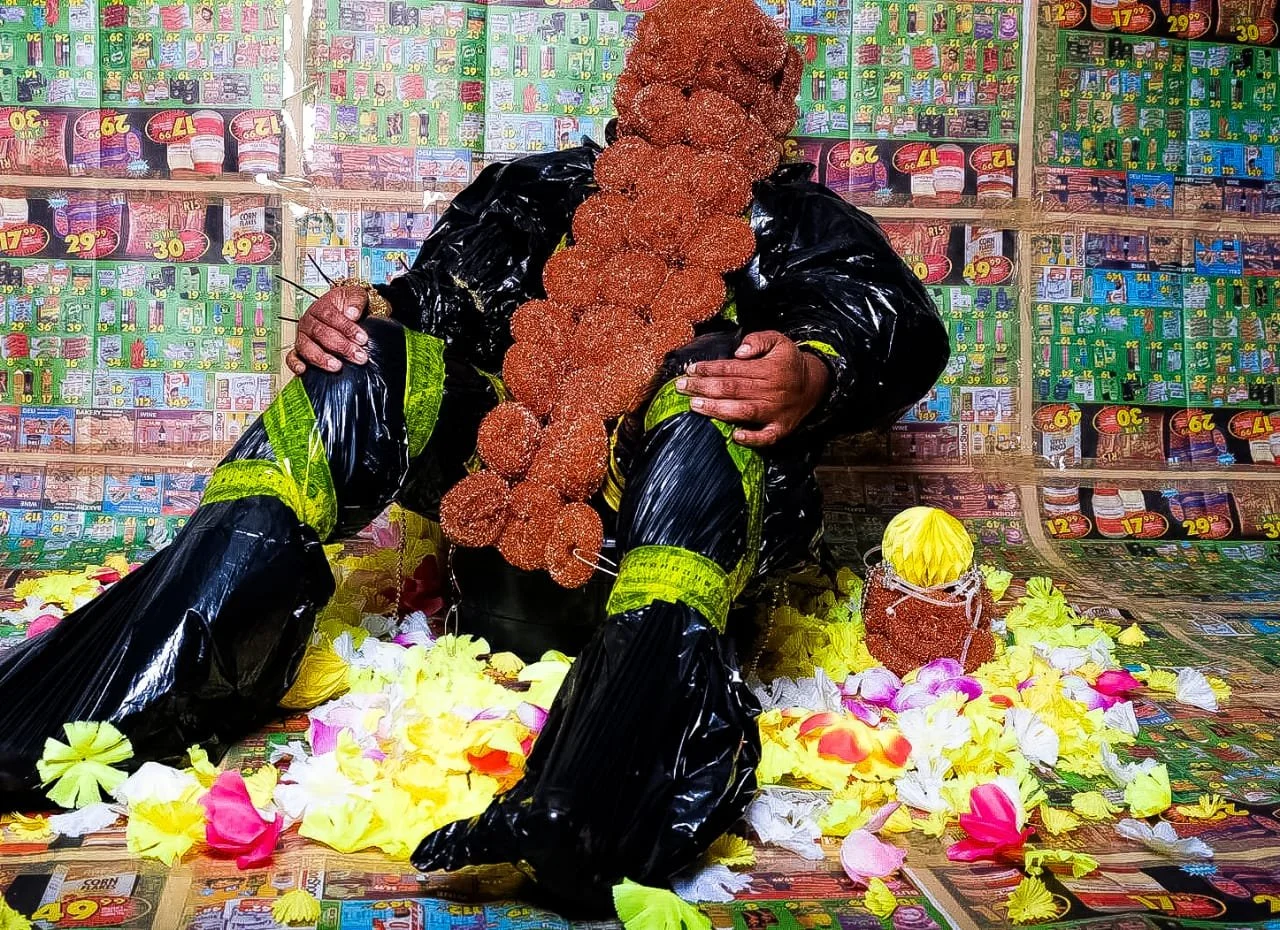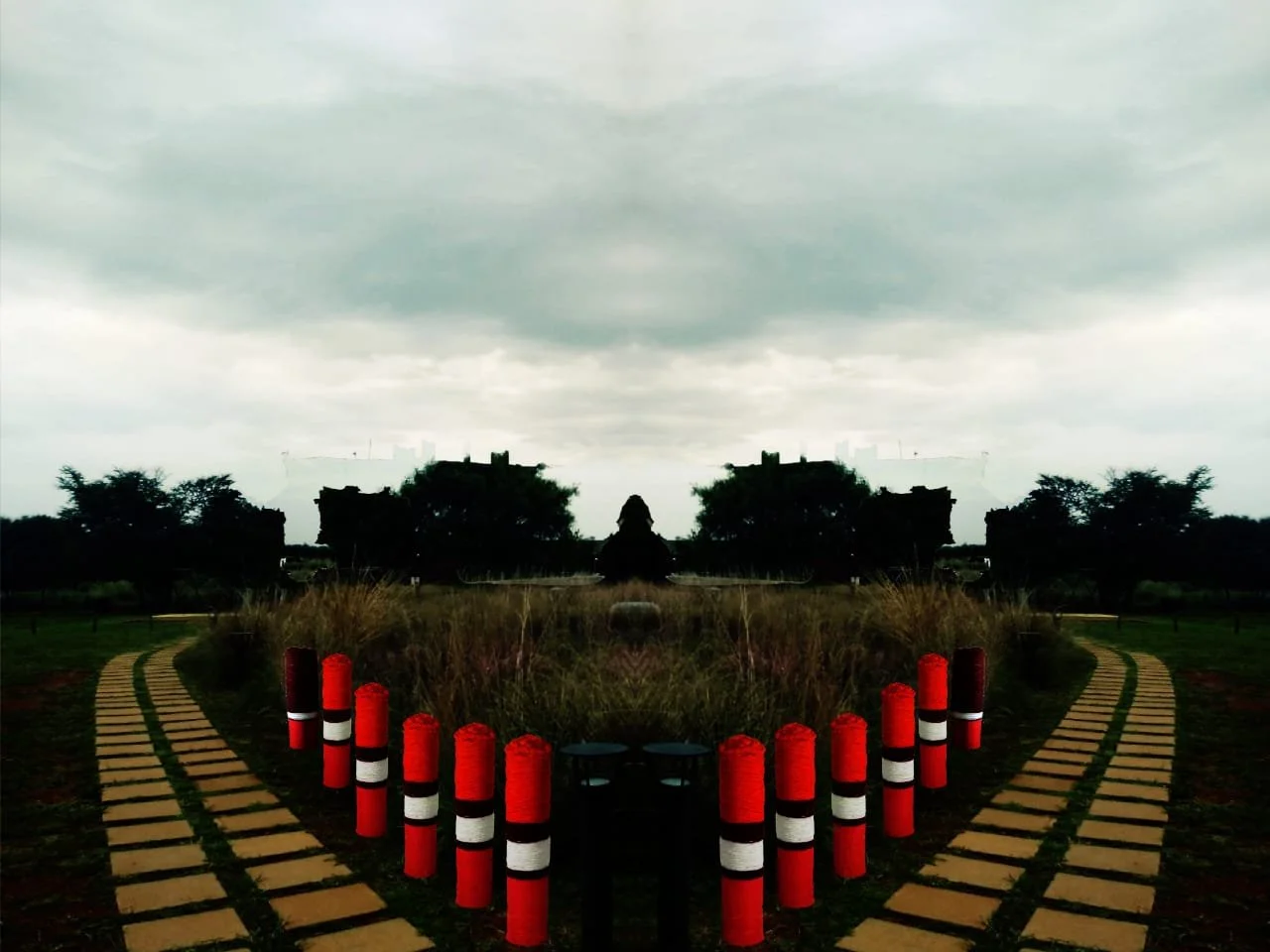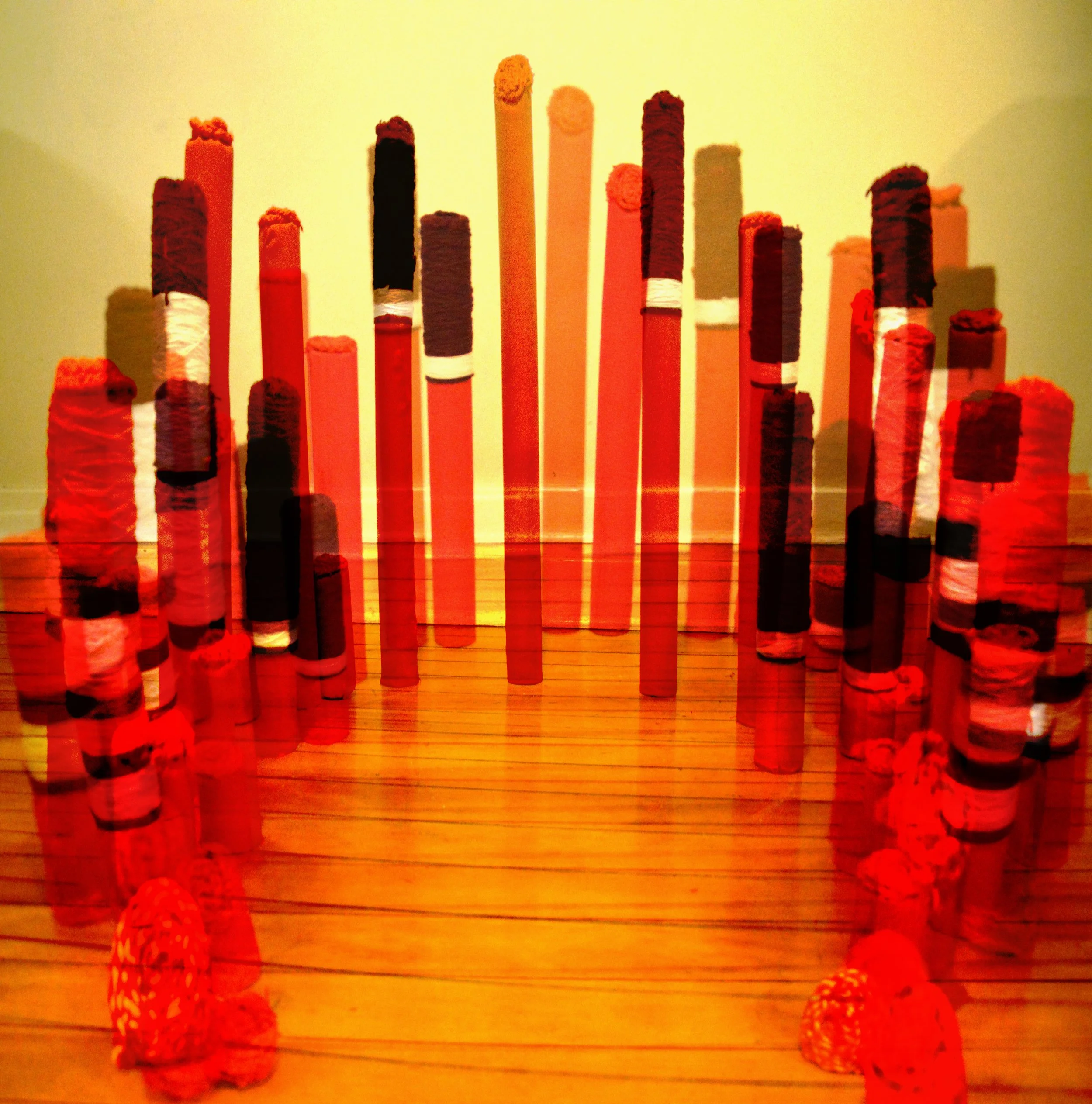Reimaging Home
Ayikho into egqith' ikhaya
Xa uxakekile une nhlungu zakho
Akhuko ndawo
Akhuko ndawo Efana nekhaya lakho
There’s nothing that beats home
When you are confused and in pain
There’s no place
There’s no place like home
Apho kukhona uthando
Apho kukhona ukunwaba
Apho kukhona izihlobo zako
‘Where there is love
Where there is happiness
Where your family is’
Ayikho into egqith' ikhaya lakho Bongo Maffin[i][ii]
In this essay I will focus on the exploration of home and homemaking in Art. I will be discussing the main points from bell hooks’ Yearning: Race, Gender and Cultural Politics to link the works of two artists Ncumisa Mcitwa and Londiwe Mtshali- whose work encapsulates and illustrates the theoretical notions developed by hooks. I will also be comparing the theoretical key points from hooks’ text and then I will illustrate how Mcitwa and Mtshali’s work encapsulates the theoretical notions that underpin the text that I will be looking at.
Home can be defined by many, but one can understand it as a place where one finds a feeling of belonging, finds some form of nurturing. A home represents the base of where a family unit resides, each home is encoded with its visual language that exemplifies what each family finds valuable. Perhaps it's a weird porcelain chicken that keeps the keys, crochet chair bags made by your grandmother or even the latest fashionable succulent plants. We all have images of what a home looks like and an idea of what it feels like to be home or outside of the home. The home houses not just our bodies but our memories. Home is an important site in the human journey and that often informs how we view the world and how we view beauty. In bell hooks’ Yearning: Race, Gender and Cultural Politics when reflecting on her grandmother’s home she states that She was certain that the way we lived was shaped by objects, the way we looked at them, the way they were placed around us. She was certain that we were shaped by space (hooks 1990) she continues that “Do you believe that space can give life, or take it away, that space has power?”(hooks 1990) . It is that exact power that we tap into when we create spaces for ourselves.
When creating spaces for ourselves we breathe life into them. For some this may not be possible due to restraints in customary law. Scholar Zamambo Mkhize states “The law of South Africa thus constitutes the paradigm case of a ‘mixed’ legal system. customary Law denotes legal systems originating from African societies as part of the traditional culture of a particular tribe”(Mkhize 2021) In this instance, I want to look at women in rural spaces. Women in rural spaces are often unable to own homes in these spaces. This is often because of culture and customary law. Culture is defined as a set of characteristics that includes the beliefs, practices, values, norms, and behaviours that are shared by the members of a group (Kasturirangan, Krishnan & Riger, 2004, p. 319). In Women and Land Tenure Rights in Southern Africa:A Human Rights-Based Approach, scholar Gladys Mutangadura states that “despite their central role in agricultural production, women in Southern Africa continue to face discrimination in accessing and owning land. Most women in the sub-region have access to farmland only through their husbands or fathers as they are only granted usufructuary rights as land titles pass through the male line” (Mutangadura 2004). I am interested in the ways that women negotiate or manoeuvre around obstacles in life to become homeowners. Mutangadura asserts that the lack of women representation in community land committees and participation in traditional community decision-making structures plays a part in the suppression of women land ownership rights and discussions about the topic. This lack of women representation inspires some artists to speak to the topic of women who are unable to become homeowners.
Moulding themes of home
An artist who looks at the representation of women homeowners and particularly those in rural areas and in informal settlements is Ncumisa Mcitwa. Mcitwa is an artist from the Eastern Cape, whose works focus on the lives of people who live in informal settlements. Mcitwa’s practice is informed by her childhood memories of playing with clay and making toys with found objects in Ncinwana Idutywa village [iii]where she was raised. She states that “I played with clay and found materials to make toys and mini sculptures. I think this is where my passion for making art” (Mcitwa 2022). It is this experience that has bled into her art-making process, especially the merging of found materials and traditional art-making materials when creating her artworks. Mcitwa uses her sensory experiences of home in creating works that deal with the concept of home. She incorporates the use of materials that are salvaged from scrap yards to create artworks that deal with women creating homes in peripheral spaces such as informal settlements, township spaces as well as rural and impoverished areas.
Figure 1: Ncumisa Mcitwa. Ikhondlo I
Most interestingly Mcitwa can access this experience of crafting and building in creating her structures. This allows Mcitwa to tap into the world of her subject matter. Creating a space in a role that is not domestic in nature but in a way that makes her the creator. Mcitwa creates an aesthetic that is formed using found materials, it is informed by the language of necessity and invention. bell hooks define aesthetics as “more than a philosophy or theory of art and beauty; it is a way of inhabiting space, a particular location, a way of looking and becoming” (hooks 1990). It is with this sensory memory which informs her way of looking, that pivots her role from observer to creator. Mcitwa explains “I look closely to women in different spaces, like the informal settlements, township spaces and impoverished areas, and play with the idea of using things they use in their areas as a symbol of representation, creating a bold and strong image to speak about the women in these spaces including disrupting the inferiority and poor image that they are represented by” (Mcitwa 2022).
Figure 2: Ncumisa Mcitwa. Ikhondolo II
Looking at the works that Mcitwa has developed in the series Ikhandlolo. [iv]I asked: how does Mcitwa’s works create a space for others? As well as how is a space for other women in rural areas? Her work is a visual experimentation, through her use of the same found objects that speak to the materiality of the spaces that Mcitwa shines a light on.
The series Ikhandlolo (the candle) which is an amazing installation piece that is like a replication of the interior of an informal settlement. The series take its name from a candle which are used by some in informal settlements for light. The patterns of the vinyl coverings both pull you in and push you out as your eye moves from patch to patch. It is immersive even with its smells (Creating of a home that invites you to look but reminds you as well that you may not belong. Ikhandlolo as a series is an act of worldbuilding that does not create a space on its own however it takes exciting spaces and subverts them. Mcitwa is able to take a gallery space with its white walls and turn it into a non-functional informal home. When reflecting on the works of McMillan scholar Elizabeth Robles observers that “ If private lives are placed under public scrutiny, they are carefully edited and constructed versions of a domestic ideal rooted more in mass appeal than the material realities of the domestic space – knitted together by memories and experiences” ( Robles 2017 ) This is the beauty of this work, because of the language that Mcitwa has used, this installation does not feel like a private place that is under scrutiny, but rather you are welcomed to the installation as a guest.
As Mcitwa’s guest you are privy to the construction of the aesthetic of home. There is a lot that can be said about home aesthetics. So much of this aesthetic is based on the sensory sense of being alive, whether that sensation is positive or negative. There are also the materials and textures that make up and cover the room's edges, the thickness of the multi vinyl that is layered and layered, with it seems slightly peeking out from behind the figure. The figure is seated on a bed of plastic flowers that are on the floor. Is dressed in an outfit that is fashioned from black plastic bags held together with yellow tape. The figure is adorned with a headdress made from copper pot scrappers with a bangle on the left hand made with wire. It is a meticulous snapshot. This image is so rich, as it creates an almost opulent style. The image although striking offers rich form in its staying in this scene which Mcitwa does effortlessly. It is her ability to make this otherwise demure seating into a stellar piece of work working from the stigma of peripheral areas like informal settlements into a site of resistance, a site that would be overlooked by people. Continuing with her meditation on home place hooks states that “Drawing on the past legacies, contemporary black women can begin to reconceptualise ideas of the home place, once again considering the primacy of domesticity as a site for and resistance” (hooks 1990). This is the resistance and reconceptualising Mcitwa does so well in taking a shack into a site for a great work. Instead of operating from stigma, Mcitwa’s Ikhandlolo celebrates informal settlements. Mcitwa states that” I believe in celebrating and depicting women as seeds of change and powerful leaders, warriors and strong being. That challenging gender roles of women that we are still tied to by culture in our communities is important” (Mcitwa 2022).
It is important for us to look to our communities and the spaces that we inhabit. This review of how we view spaces is necessary. hooks (1990) states that when we renew our concerns with the home place, we, can address political issues that most affect our daily lives. This calls attention to the skills and resources of black women who may have begun to feel that they have no meaningful contribution to make, women who may or may not be formally educated but who have essential wisdom. I believe that Mcitwa’s work draws its strength from the depth of its materiality. Her ability to make tangible spaces that are thought of as out of reach speaks to her strength as an artist who can pull from her lived experiences.
(De)constructing aspects of home
When I was younger, we used to play a game, where one would hide a belt and let the others find the belt. The one who would find it would hit those who were outside of ikhaya or Homebase. As soon as someone found the belt we would run back to Homebase. I liken this to the journey of a homecoming. The feeling of being secure, of homecoming, of being sheltered from the bad by arriving home. The homecoming you have when going to emakhaya. It is a journey. It is the feeling that bell hooks describes when going to her grandmother’s home stating: Oh! That feeling of safety, of the arrival of homecoming when we finally reach the edges of her yard, when we could see the soot black face of our grandfather, Daddy Gus sitting in his chair on the porch (hooks 1990). It is this feeling of being at home or feeling of belonging after facing adversity that can be a powerful space to work from when creating work that interrogates ideas of home.
I am aware that some people cannot relate to the feeling of homecoming. I am interested in how those who do not relate to this feeling, choose to create this space for themselves. I am interested in how we can create our homecoming and chose to make our own spaces of belonging.
A family member recently began the laborious process of building a home in our rural homestead which made me think about the role of women in rural households. More importantly about the steps or rather strides taken by women and particularly women in rural spaces to build their own homes. This may be as a result of the idea of homecoming in itself. This is because most homes in the rural areas are viewed as the main home. This is the home that people return to during the festive season or on major holidays in an act of homecoming. This difference was interesting because of the way in which we speak of these places. I noticed that a differentiation is made in the Zulu and English language between kwakho or Ikhaya lako (your place) and ikhaya lakini/ Kini (your home) and the interplay between them. Noting that there is a difference between a familial home and the home you make for yourself.
This difference made me think of the differences between a familial home and the spaces that we chose to reside and what those spaces signify culturally and spiritually. I asked how does cultural significance inform the way we inhabit spaces?
Figure 3: Londiwe Mtshali. Esibaya
This leads me to look at very specific sites in familial homes that bare cultural and religious significance. Which brought me to Isibaya which for me bares interesting symbolism as a place where life is given and taken. The imagery of isibaya for me was quite dynamic and using this imagery I began playing with the construction of isibaya and its placement in a homestead as the housing unit for cattle, as the thing that holds the livelihood of a family unit. If you could, the livelihood of the home as the cattle that resides within isibaya is very valuable.
The construction of isibaya (a kraal) was important because of this similar differentiation, for me, it was a fact of what happens when ikhaya lakini is not accessible to you? Particularly as a woman this access may change through time as you get married. This resonates with me as a woman. How does one deal with the difficulties of being unable to access one’s home and want to connect or perform certain rituals or functions or fulfil one's feeling of belonging?
Looking at ways to break the solidarity of this isibaya, looking at ilobolo. Which is defined by Dr Nokuthula Caritus Mazibuko as an age-old practice among black South Africans, s the bride price paid by the bridegroom and his family for his wife. It serves as an exchange between two families to legitimise a relationship skewed towards 'relocating the woman to a new household” (Mazibuko 2016). The also make the association of the movement of cattle as a bride price and the theme of moving as in the role of womanhood -where you move from being a child to a girl to a woman then to the bride. As a woman you are viewed as the one who brings wealth to a family because as you marry you make your family richer by virtue of ilobolo.
It is this same movement that made me look at the language of installation which is defined as a wide term applied to a range of arts practice which includes the settling or configuration of the object in space, where the entirety of the object and space include the artworks. Or a form of manufacture or display of artwork rather than movement or style (Anwarr, Bhuiyan, Kadirkaikobad and Parveen 2016). Finding a language in my art that was informed by aesthetics from my home that are linked with the most important aspects for me when making this work. Aspects that are connected to our or my spirituality, aspects that relate to the materiality of the home, be it in the textures or different materials that I associate with home. It is this encoded language that we all speak that scholar bell hooks notes when she asserts that objects are not without spirit. As living things, they touch us in unimagined ways. On this path one learns that an entire room is a space to be created, a space that can reflect (hooks 1990).
Isibaya became a meditation on homecoming. It was a visual experimentation of opting out or trying to find space in rural areas. I began to look at the spaces that Isibaya could inhabit. For me, it became a scenario where I tried to manuever around difficulties that made me unable to access my home and home spaces. A meditation on how spaces and home spaces can be constructed when we don’t have them or are without them.
Figure 4: Londiwe Mtshali. Installation of Isibaya.
The notion of constructing a home space, may take place in the actual building of a space or in the construction by furnishing a space i.e on structing the space with items and objects. There is an important point in Yearning: Race, Gender and Cultural Politics, where hooks explains that: “years ago, at an art gallery in San Francisco near the Tassajara restaurant, I saw rooms arranged by Buddhist monk Chogyam Trungpa. At a moment in my life when I had forgot-ten how to see, he reminds me to look. He arranges spaces. Moved by an aesthetic shaped by old beliefs. Objects are not without spirit. As living things, they touch us in unimagined ways” (hooks 1990). She continues that on this path one learns that an entire room is a space to be created, a space that can reflect beauty, peace, and a harmony of being, a spiritual aesthetic. Each space is a sanctuary. I remember. Baba has taught me "we must learn to see." (hooks 1990).
In conclusion, looking at themes of home and homemaking through the works of black women is an important critical engagement. This may be done in the stage of scenes of home or even in the deconstruction of home spaces This text illustrates that aesthetics are not learnt in a classroom, they are informed by our own experiences as people. Whether it is Mcitwa’s childhood experiences of playing or my own experimentations learning how to encode visuals, these explorations can create a great understanding of how to see anew. It is a constant effort of learning to see. We can surmise his engagement may not always steam from traditional artist techniques.
[i] A special thank you to Ncumisa Mcitwa for giving me so much her time and sharing her work and insight. I am grateful to Zamatshali Mtshali for taking the time to discuss my work. I am also grateful to my Online writing group for always being a safe space for me to share my ideas.
[ii] Kura Uone a song by Bongo Maffin a song about homecoming
Bibliography
bell hooks, ‘Yearning: Race, Gender and Cultural Politics’ (Boston, MA: South End Press, 1990), 40-65.
Elizabeth Robles. Maxine Walker: Imagining the homeplace (London, Oxford Art Journal) 171-183 https://academic.oup.com/oaj/article/40/1/169/3769389 by University of Witwatersrand user on 06 April 2022
Gladys Mutangadura, Women and Land Tenure Rights in Southern Africa: A human rights-based approach ( London, 2004) 1-15.
Shohel Anwarr. Zafar AlamBhuiyan. Najmul Kadirkaikobad. Shahina Parveen, ‘The Traditional and Cultural Practice of Installation Art: A Contextual Study’. Online text, (2016). https://www.researchgate.net/publication/315728488_ The_Traditional_and_Cultural_Practice_of_Installation_Art_A_Contextual_Study
Nokuthula Caritus Mazibuko, Ilobolo, ‘The Bride Price That Comes ‘At a Price’ and The Narratives of Gender Violence in Mamelodi , A South African Township’ https://www.proquest.com/docview/187680882
Zamambo Mkhize, Polygyny And Gender : The Gendered Narratives of Adults Raised In Polygynous Families (University of KwaZulu-Natal Press), 125-165




